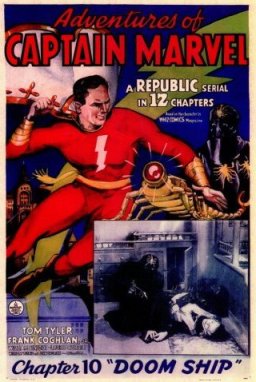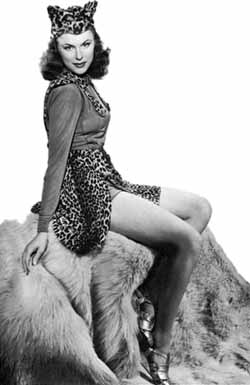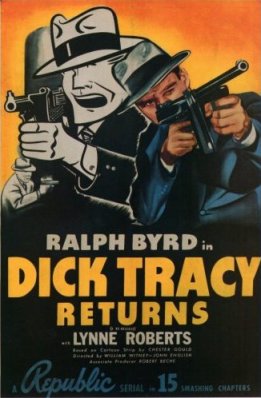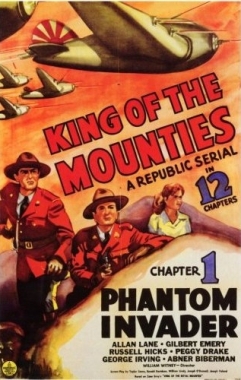
Adventures of Captain Marvel is a 1941 American 12-chapter black-and-white movie serial from Republic Pictures, produced by Hiram S. Brown, Jr., directed by John English and William Witney, that stars Tom Tyler in the title role of Captain Marvel and Frank Coghlan, Jr. as his alter ego, Billy Batson. The serial was adapted from the popular Captain Marvel comic book character, then appearing in the Fawcett Comics publications Whiz Comics and Captain Marvel Adventures. The character is now owned by DC Comics and is known as Shazam.

The Masked Marvel (1943) is a 12-chapter film serial created by Republic Pictures, who produced many other well known serials. It was Republic's thirty-first serial, of the sixty-six they produced.

Zorro's Fighting Legion is a 1939 Republic Pictures film serial consisting of twelve chapters starring Reed Hadley as Zorro and directed by William Witney and John English. The plot revolves around his alter-ego Don Diego's fight against the evil Don Del Oro.

S O S Coast Guard is a 1937 Republic film serial. It was the seventh of the sixty-six serials made by Republic. The plot concerns the mad scientist Boroff attempting to sell a superweapon to the highest bidder, opposed by Coast Guard Lieutenant Terry Kent, for both personal and professional reasons.

The Great Alaskan Mystery is a 1944 Universal film serial about government agents trying to stop Nazi spies from getting their hands on futuristic weapons.

The Fighting Devil Dogs (1938) is a 12-chapter Republic movie serial starring Lee Powell and Herman Brix, the latter better known by his later stage name, Bruce Bennett. It was directed by William Witney and John English. While not often considered a great serial, as it contains much stock footage and two recap chapters, it is famous for its main villain, the Lightning—the first costumed supervillain. There is some speculation that George Lucas used the Lightning as a template for Darth Vader.

The Tiger Woman (1944) is a 12-chapter film serial by Republic Pictures starring Allan Lane and Linda Stirling. The serial was re-released in 1951 under the title Perils of the Darkest Jungle and, in 1966, it was edited into the 100-minute Century-66 film Jungle Gold.

The Adventures of Red Ryder is a 1940 12-chapter Republic movie serial directed by William Witney and John English and starring Don "Red" Barry and Noah Beery, Sr., based on the Western comic strip Red Ryder. This serial is the 18th of the 66 serials produced by Republic.

Jungle Girl is a 1941 15-chapter Republic serial starring Frances Gifford. It was directed by William Witney and John English based on the novel Jungle Girl (1932) by Edgar Rice Burroughs. It was the 22nd of the 66 serials produced by Republic.

Dick Tracy's G-Men (1939) is a 15-Chapter Republic movie serial based on the Dick Tracy comic strip by Chester Gould. It was directed by William Witney and John English.

King of the Royal Mounted (1940) is a Republic Pictures northern serial based on the King of the Royal Mounted comic strip directed by William Witney and John English.

Darkest Africa (1936) is a Republic movie serial. This was the first serial produced by Republic Pictures and was a loose sequel to a Mascot Pictures serial called The Lost Jungle, also starring Clyde Beatty. Mascot, and other companies, had been taken over in 1935 by Consolidated Film Laboratories and merged to become Republic. Producer Nat Levine was formerly the owner of Mascot Pictures.

Dick Tracy Returns (1938) is a Republic Movie serial based on the Dick Tracy comic strip. It was the eleventh of the sixty-six serials Republic produced and a sequel to the 1937 serial Dick Tracy, with Ralph Byrd reprising his role as the title character. It was successful enough that two further sequels were released in 1939 and 1941, and Byrd become so connected with the character he went on to play him in a subsequent television series.

Hawk of the Wilderness (1938) is a Republic movie serial based on the Kioga adventure novels written by pulp writer William L. Chester (1907-1971). Kioga was a Tarzanesque white child raised on a lost island in the Arctic Circle, somewhere in northern Siberia, which was heated by thermal springs and unknown currents. Chester wrote four Kioga novels. The first, Hawk of the Wilderness (1935), was the one that was filmed as the 12-part 1938 Republic serial. (The other novels in the series were Kioga of the Wilderness, One Against a Wilderness and Kioga of the Unknown Land.

Dick Tracy vs. Crime, Inc. (1941) is a Republic Movie serial based on the Dick Tracy comic strip. It was directed by the team of William Witney and John English with Ralph Byrd reprising his role from the earlier serials. It was the last of the four Dick Tracy serials produced by Republic, although Ralph Byrd went on to portray the character again in two features and on television.

King of the Mounties is a 1942 Republic 12-chapter film serial, directed by William Witney. Allan Lane played Sgt. Dave King of the Mounties, with Peggy Drake as heroine Carol Brent, and Abner Biberman played the villainous Japanese admiral Yamata.

Secret Service in Darkest Africa is a 1943 Republic serial. It was Republic's thirtieth serial, of the sixty-six produced by the studio.

Haunted Harbor (1944) is a Republic serial, based on the novel by Ewart Adamson.

G-Men Never Forget is a 1948 Republic movie serial. The serial was condensed into a feature film in 1966 and re-released under the title Code 645.

Government Agents vs Phantom Legion (1951) is a 12-chapter American black-and-white action film serial produced and distributed by Republic Pictures Corporation in 1951. It is an original, studio-commissioned screenplay by Ronald Davidson, produced by Franklin Adreon and directed by Fred C. Brannon.













